In Brief
From October 1989 to 1991, hundreds of reports of enormous triangular objects with bright lights were recorded in Belgium. Some of the objects were tracked by both airborne and ground radar and even chased by Air Force supersonic F-16 jets.
The highest concentration of sightings began on the night of November 29th, 1989, when multiple-witnesses observed what seemed to be strange aircraft. That night a total of 143 sightings were reported in Eupen, a Belgian town about 7 miles from the German border; at least 13 of the witnesses were police officers.
The sightings continued until 1991, with over 2,000 sightings of the unknown triangular lights over Belgium reported during that time. Witnesses included military and police officers, pilots, scientists, engineers, and citizens. Over 300 of these cases were from witnesses who saw the craft from only a short distance (fewer than 300 meters or 1,000 feet away), and over 200 sightings lasted longer than five minutes. Because of this, many witnesses were also able to capture images or video of the object. Most of the reports occurred after sunset.
The Royal Belgian Air Force quickly set up a task force to investigate the sightings, led by Colonel Wilfred De Brouwer, then Chief of Operations and later Major General and Deputy Chief of the Belgian Air Force. The task force worked closely with the Belgian National Gendarmerie and civilian research group SOBEPS (Belgian Society for the Study of Space Phenomena) to collect witness testimony and determine what the unknown object was. In total, the group collected evidence for 650 of the 2,000 reported cases; 500 of these reports could not be explained or attributed to any known aircraft. SOBEPS published their research, which is publicly available. De Brouwer, now retired, has since spoken about his experience with journalist Leslie Kean, sharing compelling witness reports.
The sightings became known as the Belgian UFO wave because of the repeated and widely corroborated reports clustered in a single area. It’s one of only a handful of UFO waves reported globally, notably the 1980s Hudson Valley wave in the US. Unlike these other cases however, the Belgian wave received significant attention and resources from government and military authorities in cooperation with civilian researchers, making it one of the mostly publicly researched UFO incidents in recent history. Despite this, questions remain about what all those thousands of credible witnesses saw in the sky.
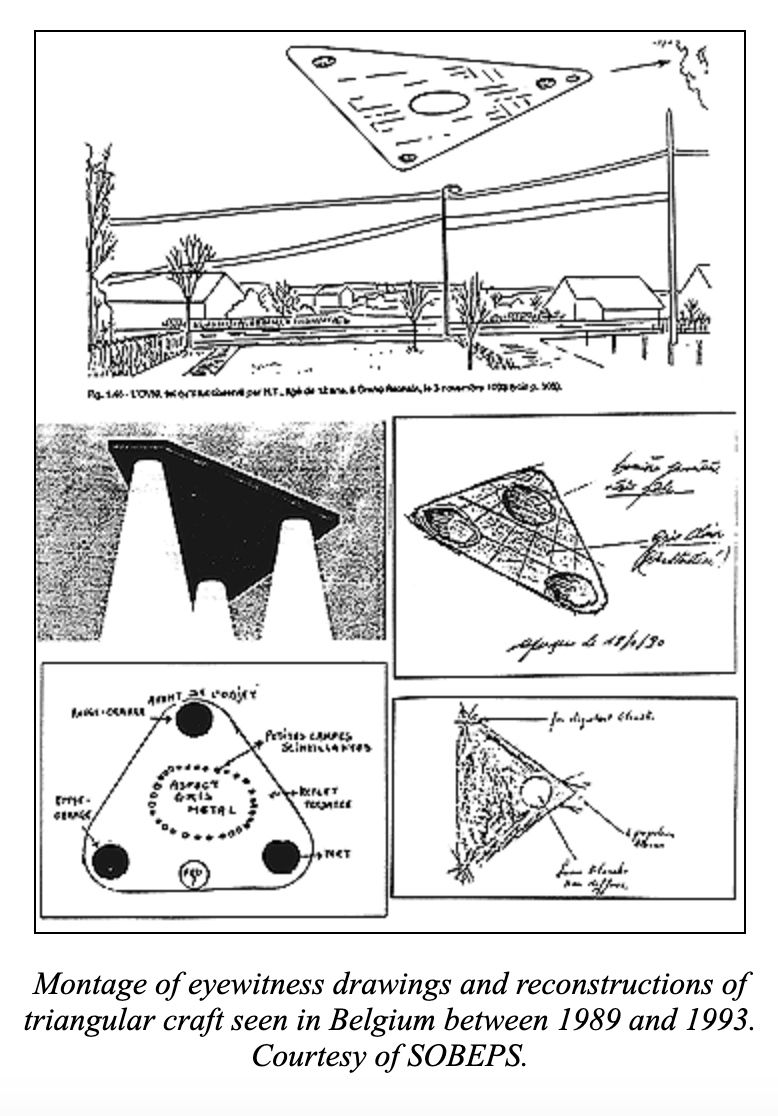
Timeline
The first reports famously came from officers Heinrich Nicoll and Hubert Von Montigny, two members of the Belgian Gendarmarie in Eupen.
On November 29, 1989, a large craft with triangular shape flew over the town of Eupen. The gendarmes von Montigny and Nicol found it near the road linking Aix-la-Chapelle and Eupen. It was stationary in the air, above a field which it illuminated with three powerful beams. The beams emanated from large circular surfaces near the triangle's corners. In the center of the dark and flat understructure there was some kind of 'red gyrating beacon.' The object did not make any noise. When it began to move, the gendarmes headed towards a small road in the area over which they expected the object to fly. Instead, it made a half-turn and continued slowly in the direction of Eupen, following the road at low altitude. It was seen by different witnesses as it flew above houses and near City Hall.- Professor Auguste Meessen ("Observations, analyses et recherches" Chapter 10 in Vague d'OVNI 2)
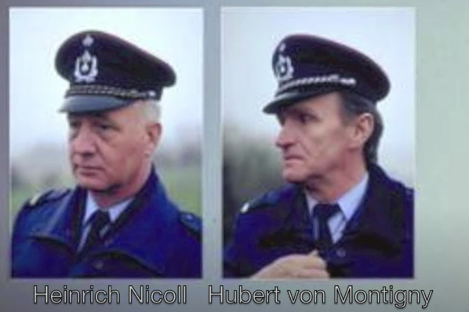
At 5:15 p.m., while patrolling the road between Eupen and the German border, the two officers saw a nearby field lit with “such intensity that they could read the newspaper in their car.” (De Brouwer via Kean, 24) Hovering above the field was a large triangular object, about 30 meters long on all sides, with three spotlights beaming down from each respective corner, and one flashing red light emanating from the center. It was completely silent.
For two minutes the object moved slowly toward the German border, before suddenly turning back towards Eupen. The policemen pursued it as it floated over the city for about thirty minutes, where it was witnessed by several other independent witnesses.
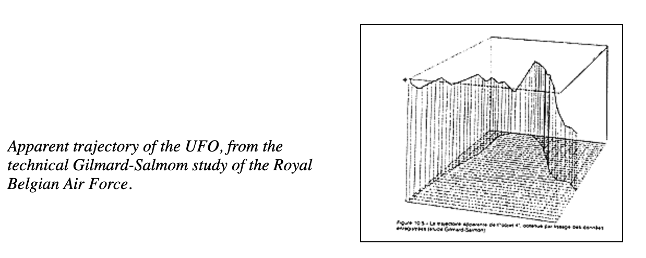
The officers then followed the object to Lake Gileppe, where it stopped and hovered in place for about an hour. The object emitted two beams of red light which slowed as they extended downwards, stopped, disappeared—leaving behind two red balls of light, which would then float back up and rejoin “the craft” (General De Brouwer often refers to it this way in his accounts). This sequence of events continued to repeat in a cycle, with each repetition lasting several minutes. Von Montigny said it was “like a diver shooting an arrow from an underwater gun that slows down at the end of its trajectory and is subsequently retrieved by the diver.”
Around 6:45 p.m., the officers saw a second triangular craft suddenly appear from behind the trees of a nearby woodland. The top point of the triangle tilted downwards, exposing the topside of its fuselage: a dome with what appeared to be rectangular windows lit from the inside. This second object departed north, and soon after, at 7:23 p.m., the first object stopped shooting its strange red balls of light and also moved off to the southwest.
Nicoll and Von Montigny were in radio contact with their dispatch the entire time, so were able to continue tracking the object to the village of Henri-Chapelle, where two other officers witnessed it hovering overhead. They did not experience any electromagnetic effects, such as radio interference, during the encounter, which is consistent throughout witness reports.
The other two officers, Dieter Plummans and Peter Nicoll (no relation to Heinrich Nicoll) watched the object, roughly 100 meters away from them, hover at about 80 meters off the ground by a nearby monastery. Initially completely immobile and silent, the object started to make repeated “hissing sounds” that seemed to dim the intensity of the object’s lights each time they were emitted. A red ball of light suddenly dropped directly downwards from the center of the craft, and then turned on off on a directly horizontal path, disappearing behind the trees. Both policemen were terrified. The craft moved directly over their vehicle and headed northeast. They followed it for approximately five miles until they lost sight of it, but Nicoll and Von Montigny were still able to continue to follow its movements from their position south of the highway.
Many civilians also reported strange objects to the Gendarmarie that night. De Brouwer mentions a family of four driving on a highway west of Liège who saw “a rectangular platform above them, made visible by the highway lights. They reported that it slowly passed overhead at a low altitude, with a spotlight in each corner.”
Out of the 143 sightings reports made that night, De Brouwer and his team fully investigated seventy. None of them could be “explained by conventional technology.” De Brouwer also surmised that the 143 reports represented only a fraction of the total witnesses: “Considering that approximately one person out of ten makes the effort to report their experience, the team of investigators and I estimated that more than 1,500 people must have seen the phenomenon at more than seventy locations from different angles during that afternoon and evening.” (De Brouwer via Kean, 27)
After the initial flurry of sightings on November 29, witnesses continued to report unknown objects for several years. Though no single night generated as many reports as in November 1989, the sightings consistently described a triangular, silent object with red or bright lights over Eastern Belgium.
On December 11, 1989, 21 witnesses, including a Lieutenant Colonel in the Belgian Army, all reported similar descriptions of a triangular craft.The first reports that night came from a family who watched the strange object for fifteen minutes. The object initially hovered immobile nearby before ascending vertically and passing over their house. The family’s 12 year old son made drawings of the craft from three different angles as it moved overhead: a frontal view (bottom right), a view when it was almost overhead (bottom left), and a view when it was fully overhead (top). The object’s profile looked notably different from each angle, which researchers have suggested accounts for some of the inconsistencies across witness reports. for some of the variety of objects described in witness reports.
Fifteen minutes after the object disappeared from the family’s view, Lieutenant Colonel André Amond, a civil engineer in the Belgian Army, saw three large light panels in triangle formation over top of a pulsating red light as he drove through the countryside with his wife. He was driving faster than the object, but when he stopped and got out of his car to observe it, the panels caught up and turned to face him. The pulsating red lights disappeared, and in their place shone a large bright spotlight, twice the size of the full moon, which came within 100 meters of the couple. Frightened, the colonel’s wife asked to leave. Before Amond climbed back into his seat though, the bright white light turned away, revealing the three red panels and the pulsating center light on its underside. The couple never saw a supporting mass connecting the lights. The object sped away at “an alarming rate” and disappeared into the sky.
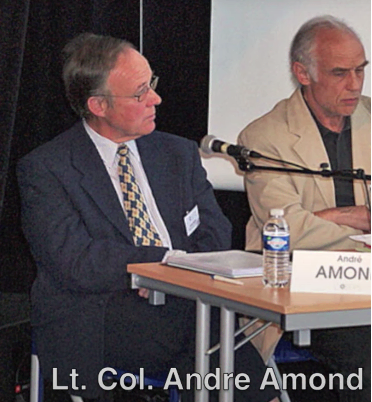
During a recent review of the investigation, another witness came forward to report that she had seen the same object on her walk home from the train at Ernage railway station, just five minutes before Amond and his wife encountered it.
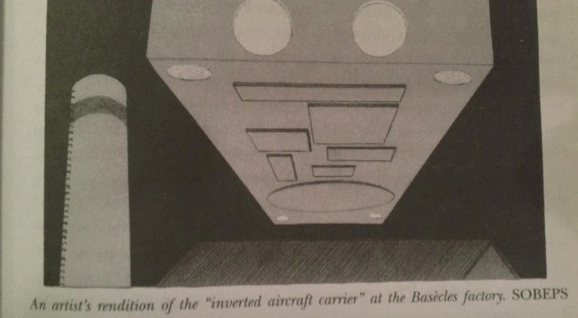
Appearance
However not all witnesses saw a triangular object, instead reporting a trapezoid figure in the sky. On April 22, 1990, two witnesses reported a giant, grayish object in the shape of an upside-down trapezoid moving slowly and silently above the chimney of their house, at one point covering their entire 100 × 60 meter courtyard. They described six lights coming from the object and structures hanging from its bottom that gave it the appearance of “an aircraft carrier turned upside down.” A similar object was observed in March 1991.
Some witnesses also reported “communicating” with the unknown objects. At 10:35 p.m. on July 26, 1990, Mr. and Mrs. Marcel H. were driving home through the municipality of Grâce-Hollogne towards Seraing, when they saw a stationary object in the sky up ahead. The object was dark and shaped like an equilateral triangle, about twelve meters on each side, with white strips of neon-like light along two of its edges. There were spotlights shining down from each of the corners, which seemed to be detached from the object but connected to each other by a support beam, and a flashing red and a green light at the triangle’s center. Mr. H. said to his wife: “For the fun of it, I am going to flash my lights.” He flashed his headlights twice, just to see if the craft would respond. Immediately two white lights at the base of the triangle pointed towards their car and flashed off and on again, three times in a row. Keeping its lights pointed at the moving car, the object moved toward the couple, coming within 100 meters and following them as they continued driving. The object kept pace with the car as it drove 60-70 km/hr, remaining a consistent distance from the road. Interestingly, Col. Amond also reported that the unknown object came within 100 meters of his car before moving away. “By the time they approached the bridge at Seraing, Mr. and Mrs. H. were quite frightened. Finally, the object crossed the river Meuse right next to them without making any noise, and then started to climb, rapidly departing in the direction of Grâce-Hollogne.”
In a 2009 interview, NARCAP chief scientist Richard Haines notes that this kind of “communication” with unidentified phenomena is not uncommon across his database of 3,400 sightings. Military personnel have attempted to communicate in Morse code with anomalous objects and have reported responses of some kind, indicating a level of intelligence. Haines makes the distinction that these responses are not simply a “mirror” effect or simple repetition back.Instead witnesses typically report that the object first takes a concerted pause, before responding with a different iteration of the original pattern, as is seen in the case of Mr. and Mrs. H. (Paracast, April 2009)
Radar Evidence and the F-16 Scramble
On March 30, 1990, two F-16[1] jets were scrambled to investigate an anomalous radar report. According to De Brouwer,
On the evening of March 30–31, 1990, an F-16 launch was initiated after the observation of strange lights by several policemen, and after an assumed flying object was confirmed by two military radar stations. Once aloft, the pilots tried to intercept the alleged crafts, and at one point recorded targets on their radar with unusual behavior, such as jumping huge distances in seconds and accelerating beyond human capacity.- De Brouwer (Kean, 37)
Though the pilots never established visual contact with the object, they did record radar data of its extremely unusual maneuvers. Hundreds of Belgian citizens also saw the fighter jet overhead, peaking public interest in the wave.
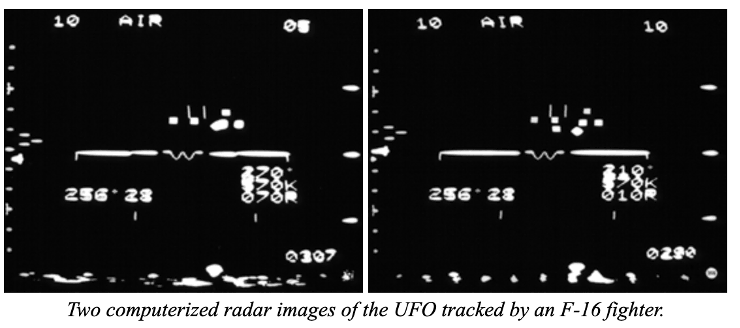
Major P. Lambrechts of the Belgian Air Force General Staff prepared a preliminary report about the scramble, which was released to SOBEPS. Titled the "Report concerning the observation of UFOs during the night of March 30 to 31, 1990," it includes a detailed chronology of events and dismisses several hypotheses such as optical illusions, balloons, meteorological inversions, military aircraft, holographic projections, etc.
The report states that at 10:50 PM on March 30th, the Gendarmerie telephoned the radar "master controller at Glons[ae]" to report "three unusual lights forming an equilateral triangle." More gendarmes called the base to report the lights in the following minutes. When the NATO facility at Semmerzake detected an unknown target[af] at 11:49 p.m, the authorities decided to scramble two F-16 fighters[ag] to investigate. The jets took off at 12:05 p.m. on March 31st from Beauvechain, the nearest air base, and flew for just over an hour. According to Major Lambrecht's report:
The aircraft had brief radar contacts on several occasions, [but the pilots]... at no time established visual contact with the UFOs... each time the pilots were able to secure a lock on one of the targets for a few seconds, there resulted a drastic change in the behavior of the detected targets... [During the first lock-on at 0:13 hrs.] their speed changed in a minimum of time from 150 to 970 knots [170 to 1,100 mph and 275 to 1,800 km./hr.] and from 9,000 to 5,000 feet [2,700 m. to 1,500 m.], returning then to 11,000 feet [3,300 m.] in order to change again to close to ground level.- Major Lambrecht
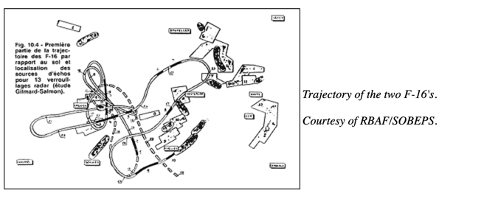
The Electronic War Center (EWC) of the Air Force[ah] undertook a detailed technical analysis of the F-16 computerized radar tapes. The study was also reviewed by Professor Auguste Meessen[ai], professor of physics at the Catholic University in Louvain and a scientific consultant for SOBEPS, who released his findings in a report.
The EWC study hypothesized that some of the radar contacts were really "angels" caused by a rare meteorological phenomenon[aj].
Although many aspects of this case still remain unexplained, Meessen and SOBEPS accepted this hypothesis, citing four radar lock-ons “where the object descended to the ground with calculations showing negative altitude... It was evidently impossible that an object could penetrate the ground, but it was possible that the ground could act as a mirror.”
Meessen explains how the high velocities measured by the Doppler radar of the F-16 fighters may have resulted from the effects of interference. He points out, however, that there is another radar trace for which there is no explanation to date. [ak]
As for the visual sightings of this event by the gendarmes and others, Meessen suggests that they could possibly have been caused by stars seen under conditions of “exceptional atmospheric refraction.”[al]
Despite these conclusions, Major General De Brouwer continued to believe in the validity of the eyewitness reports. As he later reflected in an interview with Open Minds investigative reporter Antonio Huneeus on October 5, 1995:
What impressed me the most were the witnesses, some of whom I know personally and convinced me that, in fact, something was going on. These were credible people and they told clearly what they saw…we always look for possibilities which can cause errors in the radar systems. We can not exclude that there was electromagnetic interference, but of course we can not exclude the possibility that there were objects in the air. On at least one occasion there was a correlation between the radar contacts of one ground radar and one F-16 fighter. This weakens the theory that all radar contacts were caused by electromagnetic interference. If we add all the possibilities, the question is still open, so there is no final answer.- Major General De Brouwer
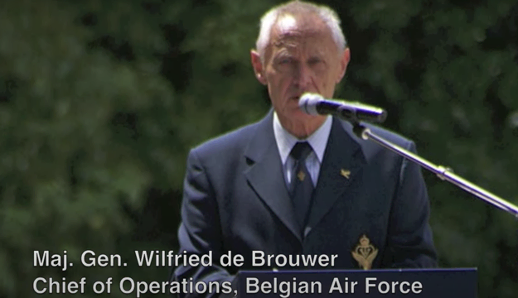
General De Brouwer has since called for a more objective and better coordinated[am] investigation of the UFO phenomenon, continuing to advocate for the witnesses after his retirement. He has also expressed dismay about the stigma around UFOs that often prevents witnesses from reporting their experience:
Some witnesses who made reports in 1989 are still hounded and discredited to this day…several witnesses didn’t dare to reveal their names; some didn’t even take the risk of reporting their sightings. I had personal experience with two different people—a journalist and a NATO employee—whom I knew for many years: They verbally reported two sensational sightings but didn’t want (or dare) to put anything on paper.- (Kean 38)
In 2007 he spoke to these issues at an international press conference at the National Press Club in Washington D.C., organized by investigative journalist Leslie Kean and filmmaker James Fox.
Debunkers and Explanations
Most debunkers theorized that the unknown objects were actually misidentified helicopters or stealth crafts.In his book on the events, UFO debunker Renaud Leclet suggested that the Belgian witnesses actually saw helicopters, [due to xx - why helicopters]. This explanation was not widely acepted though, since many reported maneuvers were well beyond the performance capabilities of any known helicopter, and the UFOs were almost always reported as being completely or nearly silent.
Debunkers have also suggested that the UFO was actually American stealth fighter test crafts. [xx explain more- there were US military bases nearby, this was around the time the US was testing the Nighthawk or whatever idk]. However UFO researchers such as Ted Roe, co-founder of respected independent research nonprofit NARCAP, have pointed out the unlikelihood of a government black project operating so publicly. General Wilfried De Brouwer also confirmed with U.S. intelligence officials that there were no military test flights, black or otherwise, in the area at that time. [is that response public?]
Leo Delcrois, Belgian Minister of Defense at the time, also confirmed this in a letter to French researcher Renaud Marhic:
"Unfortunately, no explanation has been found to date. The nature and origin of the phenomenon remain unknown. One theory can, however, be definitely dismissed since the Belgian Armed Forces have been positively assured by American authorities that there has never been any sort of American aerial test flight."
Marc Hallet put forward an entirely different explanation: the sightings were all a mass delusion. In an essay about the Belgian UFO wave, he criticized the work done by SOBEPS, arguing that the group was spreading misinformation in the media and encouraging the delusion. However this theory is not supported by social scientific literature. [was it further investigated?]
Petit-Rechain Controversy
On April 4th, 1990, a couple in the town of Petit-Rechain claimed that they had managed to photograph a triangular craft hovering near the town. A man named “Patrick” submitted the photo, though he remained otherwise anonymous. The now-famous photo was sent for analysis at both the French National Space Research Center (CNES) and the Belgian Military Academy. When researchers overexposed the picture they discovered that a triangular shape was visible beneath the lights. A more recent analysis of the photo also showed a halo of light surrounding the craft, indicating the presence of a magnetic field.
Further studies were performed by NASA scientist and NARCAP founder Dr. Richard Haines in 1994, and by physicist Dr. Andre Marion in 2001. All analyses agreed that the photo was not only genuine, but showed a real craft of unknown origin with unique characteristics. No study found any evidence of tampering with the image
Despite these consistent results, UFO skeptics have long denied the photo’s credibility. [The photo did not surface until 4 months after the purported sighting - rephrase / add more detail.] No images appear in the background that would allow researchers to determine the object’s size or distance from the photographer,, so it could as easily be a tiny model viewed close-up to make it look likea giant hovering craft. In the 1990’s, the Belgian skeptic Wim van Utrecht used a small model to successfully reproduce the photo.
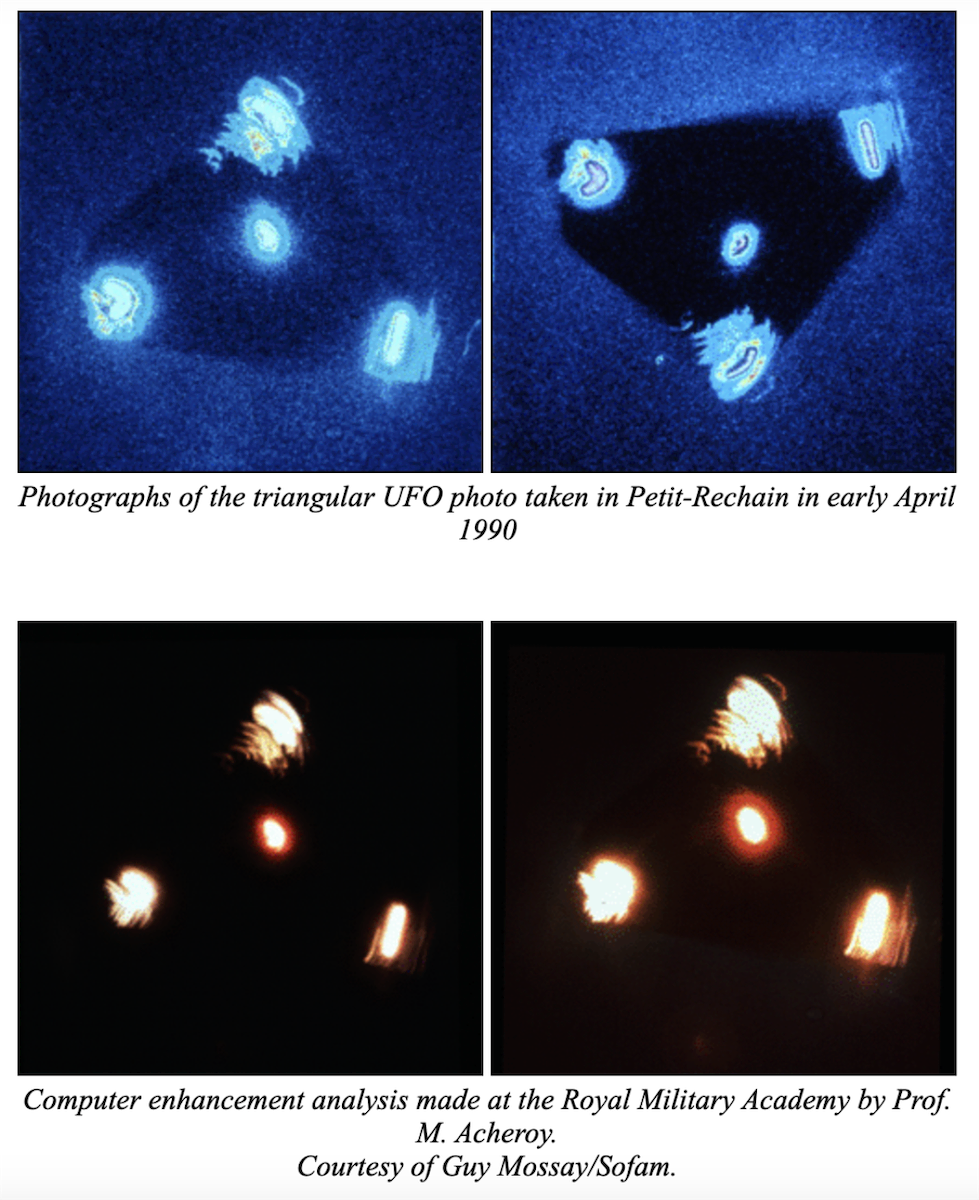
In 2011, after 21 years of complete anonymity, someone came forward claiming that they had created the hoaxed photo. Belgian news organization RTL (Radio Télévision Luxembourg) published an interview with a photographer named Patrick Marechal, who claimed to be the original “Patrick” and said that he had hoaxed the photo when he was 18 years old: “The UFO of Petit-Rechain is not a spaceship from a distant galaxy but a panel of painted styrofoam with three spots affixed.”
However, Marechal’s claims of a hoax could not be easily verified. He refused to produce the contact information for his then-girlfriend, the only corroborating witness, and could not convincingly recreate the photo using the method he described to RTL. There were also light anomalies discovered in laboratory analyses that would indicate the photograph was genuine.
Professor Marion, who performed the 2001 photo analysis, did not believe Marechal. "It seems difficult to envisage a hoax created with a model or other similar device. This is confirmed by the digital analysis…The existence of the 'lines of force’ (i’m not sure what he means here; need someone good at french) is a strong argument against the thesis of a hoax, which would be particularly sophisticated. Moreover, it is unclear why a forger would have bothered to imagine and realize a complex phenomenon, especially since it is not noticeable without sophisticated processing of the slide." Andre Marion "Nouvelle Analyse de la Diapositive de Petit-Rechain" (A New Analysis of the Petit-Rechain Slide, 2002)
In general though, most researchers agree that the photo should be handled with extreme skepticism, given the lack of background images and the unexplained delay between the original sighting and the emergence of the photo.